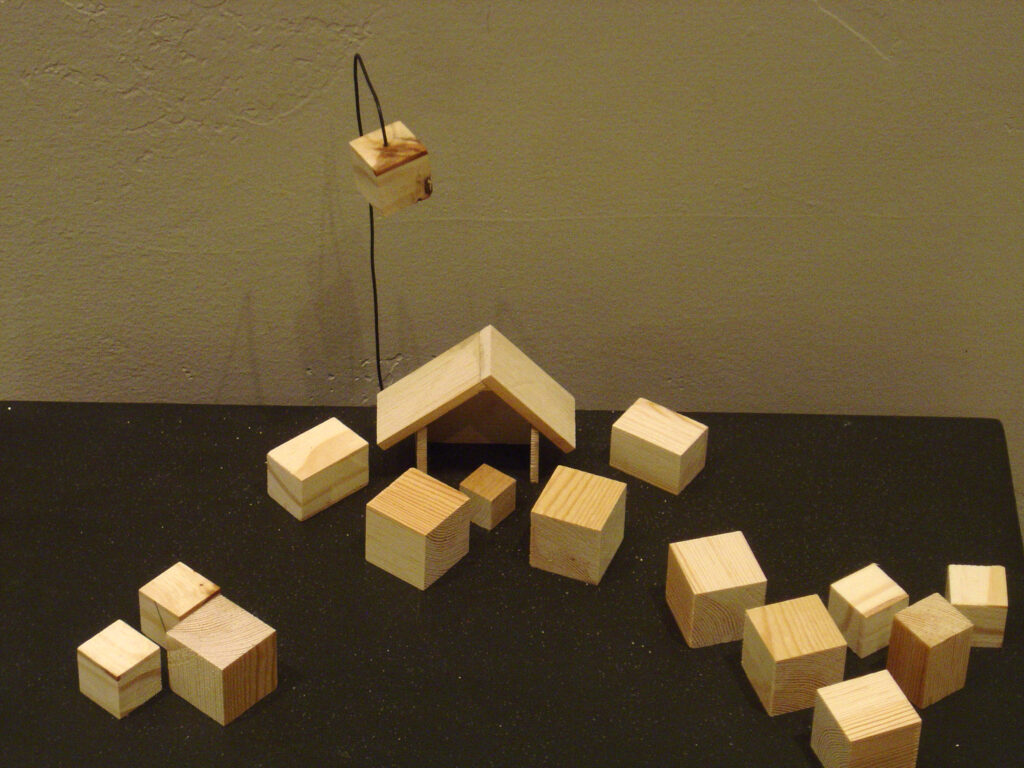This project is a response to John Searle’s Chinese Room. It explores child-writing and child-speech as protolanguages, unintelligible in any conventional linguistic sense but rife with poetic possibilities and communicative in other registers, on the level of shared biological and developmental experience. The system is composed of a number of static materials and two active agents: a child speech synthesis system, and a mechatronic child drawing apparatus. The system operates in cycles: synthesizing child speech, which is then interpreted and transcribed by speech recognition system, in turn launching the drawing machine into a round of additions to a cumulative drawing on the wall. As the cycle repeats, periodic bursts of child speech are followed by the sounds of stepper motors and pen-and-ink inscription.
Children’s voices were sourced from an online speech research database, and videos of children babbling and learning speaking their color words. Child drawings were gathered from a range of sources demonstrating different levels of representational and typographic development. My eye and hand were the means of data entry for the children’s drawings: I traced them into the system using the recording apparatus at left. This produced position-time series of pen motions which were broken apart and re-synthesized as the source data for the system’s machine drawings.
Continue reading Searle’s Room →
On Monday, I presented my paper Not Me: Collaboration and Co-production with Language Processing Systems at the Digital Arts and Culture conference 2009.
In the paper I discuss integration of language processing technologies into a studio practice, and language-based interaction in interactive artwork.
A lot of people I respect were in the room. It went… ok. It will only get better.
http://dac09.uci.edu/day2.html
2004
I set out on this project with the goal of writing a computer program to generate my term paper my graduate studies seminar this fall (of 2004). I knew from the beginning that I wanted to write about Keith Tyson as one of the artists for my paper, and he has spent many years working with various systms he has built to automate various parts of the creative process, including his Artmachine from the 90s, which is the first one I really fell in love with–it generated detailed descriptions of works of art that he would then go and make. It seemed like an attractive parallel gesture to write a program to write my paper about him. Developing this project additionally let me indulge my interests in natural language processing and natural language generation. I wanted to investigate text generation programs as (1) labor saving device and (2) an analogous process to his artmaking machines. I chose Matthew Barney and Natalie Jermemijenko, the two other artists I am most interested in at the moment to feature as the 2nd and 3rd points of my paper.
I set out to simultaneously pursue the development of two papers. One, the paper that became dadengine termpaper (the programmed paper), and the paper that became robertengine termpaper (the hand generated paper). Along the way I also picked up the travesty termpaper, another computer generated paper of slightly different quality and method than the dadaengine termpaper.
I wanted to specify the minimal structure necessary to produce a legible paper. I pursued the development of the computer generated and robert generated papers simultaneously, and any effort that I put into structuring the computer generated paper could be recycled into structure for the robertengine termpaper. The computer generated termpaper was not going to have any structure that I didn’t put there. I suspect that it can’t generate as reasoned, rational argument. (Of course, you may wonder if I could either…) I’m not sure whether it really worked to recycle structure for the robertengine termpaper. This was a totally backwards way to write an essay.
I came in with an open mind, trying sincerely to make the computer version work. Starting with the postmodernism generator, I stripped out references that were irrelevant or false, and began to load it up with actual information from the research that I had done. I’ve turned in the travesty termpaper under my real name, and the robertengine termpaper under a pseudonym to fulfill the requirement for the class.
The results follow:
| Travesty |
“Productive disciplines in the work of Matthew Barney, Keith Tyson, and Natalie Jeremijenko: Internal, Algorithmic, and Scientific Systems. “ |
| DadaEngine |
“Engineered art: the Barney’s Drawing Restraint, Tyson’s Artmachine, and Jermeijenko’s Suicide Box.” |
| RobertEngine |
“Productive Disciplines and Systems of Restraint in the Works of Matthew Barney, Keith Tyson, and Natalie Jeremijenko.” |
| bonus |
10,201 pages of Travesty text on Barney, Tyson, and Jeremijenko (34Mb txt) |

Natural Language is a hybrid studio/programming project exploring the creative process through language–mining the gap between linguistic description and the direct experience of images, objects, and events. Textual descriptions–catalogued, parsed, and analyzed with language processing tools–are used as handles to manipulate diverse collections of material, and to guide formal decisions as to the final structure of pieces. Each object is a collaboration between the artist and computer: the computer responding to the artist’s input with candidate projects, and the artist manufacturing them in turn.
This project is an effort to directly locate the computer in the studio situation, reacting to a perceived seperation between engineering and studio practices, and to postulate new roles for computer technologies in the creative process. Building on the degree of personal involvement and implication of identity developed in the Megahal Grandmommy and Father-Daughter Art Show projects, this new work extends those strategies into the realm of database operations. Natural Language explores the articulation (and archiving) of ideas and influences as a form of self-analysis and psychological performance, and situates a computational language processing system as an intervening force in the creative process.
Continue reading Natural Language →
